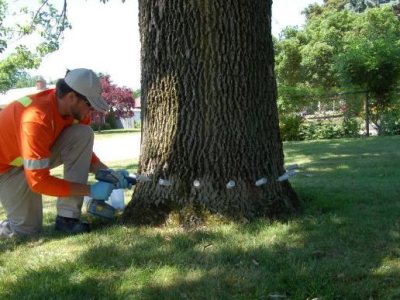It’s Murphy’s Law that the day you get great news you aren’t around to receive it. So it went for Joe Meating in early October.
When he received confirmation from the Pest Management Regulatory Association (PMRA) that his company’s product, TreeAzin, had finally earned full registration for use in Canada, nobody was in the office to get the memo. But, two days later, when Meating opened his email, the office went into celebration mode.
“We had emergency registration for emerald ash borer in Ontario and Quebec for the last four years,” said Meating, president of BioForest Technologies in Sault Ste. Marie. “We have it registered in the U.S. and we were just waiting for the full registration in Canada so that we could expand the market to all 10 provinces and territories and also deal with other insect problems, not just emerald ash borer.”
Developed in 2001 by BioForest Technologies Inc., TreeAzin is an injectable organic pesticide manufactured from the Indian neem tree that’s designed to combat the onset of emerald ash borer (EAB), the emerald green beetle that destroys ash trees by burrowing into the bark, eating the tree from the inside out and eventually killing it.
Approval from the PMRA, a department of Health Canada, means that BioForest can start promoting the pesticide to other markets. A marketing campaign is under development, and Meating is scheduled to present at a number of conferences and seminars across the country within the next few months. Eventually, once sales are stable in Canada, BioForest will reach out to a global audience.
The company is simultaneously undertaking research and development on a new injection system, which could be ready for 2013, and new formulations for pest management.
There was a spike in the incidence of EAB in Quebec and Ontario this past summer, which resulted in an increase in sales, Meating said. While the rest of Canada hasn’t yet been bugged by the pest, Meating expects the other provinces will see its onset within 10 to 15 years.
But there’s no shortage of other insect populations in need of control measures, including the Asian long-horned beetle, which attacks healthy hardwood trees such as maple, elm, poplar and willow. The beetle could also be a threat to maple syrup production in Canada.
“It’s more or less out of control in the northeastern U.S. states, so it’s not all that far from the maple industry in Quebec, and people are nervous there,” Meating said.
BioForest has been doing preliminary studies on maple syrup for food crop production to see if it can help the industry, but it will have to submit to the PMRA once again to extend TreeAzin’s use to food products. It’s not a matter of if EAB will show up, but a matter of when, Meating said.
To augment sales of TreeAzin, BioForest is looking at bringing in other tree care products manufactured elsewhere. The company is partnering with a Finnish company on a product that manages red pine disease, which Meating estimates will be commercially available in 2014. BioForest is also looking into a product to treat Dutch elm disease he said “holds promise.”
All of these products will have to get approval from the PMRA before going into commercial use, but introducing new products is all part of BioForest’s five-year plan to secure its future.
“We don’t want to have just one product here—you’re pretty vulnerable then,” Meating said. “So we’re going to try to come up with a range of different projects over the next few years.”




